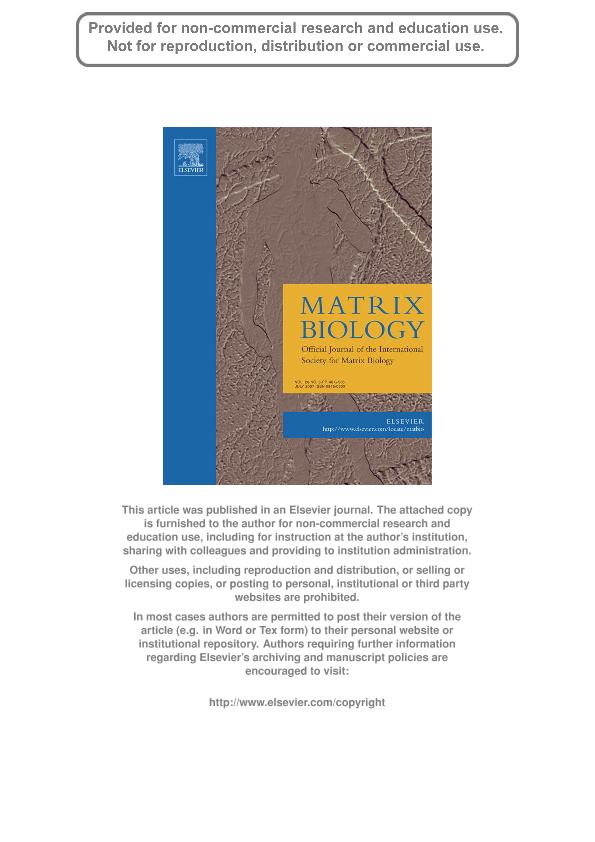Mostrar el registro sencillo del ítem
dc.contributor.author
Zizola, Cynthia F.
dc.contributor.author
Julianelli, Vanina Laura

dc.contributor.author
Bertolesi, Gabriel
dc.contributor.author
Yanagishita, Masaki
dc.contributor.author
Calvo, Juan Carlos

dc.date.available
2017-11-01T18:23:14Z
dc.date.issued
2007-12
dc.identifier.citation
Zizola, Cynthia F.; Julianelli, Vanina Laura; Bertolesi, Gabriel; Yanagishita, Masaki; Calvo, Juan Carlos; Role of versican and hyaluronan in the differentiation of 3T3-L1 cells into preadipocytes and mature adipocytes; Elsevier; Matrix Biology; 26; 6; 12-2007; 419-430
dc.identifier.issn
0945-053X
dc.identifier.uri
http://hdl.handle.net/11336/27343
dc.description.abstract
We have previously shown that during the adipose conversion of these cells the culture medium changed its viscoelastic properties due to the presence of hyaluronan and a chondroitin sulfate proteoglycan [Calvo, J.C., Rodbard, D., Katki, A., Chernick, S., and Yanagishita, M., 1991. Differentiation of 3T3-L1 preadipocytes with 3-isobutyl-1-methylxanthine and dexamethasone stimulates cell-associated and soluble chondroitin 4-sulfate proteoglycans. J. Biol. Chem. 266, 11237-11244., Calvo, J.C., Gandjbakhche, A.H., Nossal, R., Hascall, V.C., and Yanagishita, M., 1993. Rheological effects of the presence of hyaluronic acid in the extracellular media of differentiated 3T3-L1 preadipocyte cultures. Arch. Biochem. Biophys. 302, 468-475]. Here, we analyze the time course for the appearance of these molecules during drug-induced cell differentiation. The synthesis of both hyaluronan and the proteoglycan, was maximal at 48 h in the presence of isobutylmethylxanthine and dexamethasone, but while hyaluronan remained high after changing the culture medium, the proteoglycan dropped to almost basal levels after a few days. Northern analysis revealed the presence of message for a "versican-like" molecule as well as the possibility of alternative splicing. Three major bands of 9.39, 8.48, and 7.69 kb appeared in the analysis. These bands showed a dramatic increase in intensity when RNA from non-differentiated cells was compared to differentiating 3T3-L1 cells. In addition, when the time course of appearance for this message was analyzed, it perfectly correlated the metabolic labeling of the glycosaminoglycans during cell culture. The nucleotide sequencing of two exons revealed between a 100-94% homology with proteoglycan PG-M from murine endothelial cells. At least 13% of the proteoglycan was able to bind hyaluronan. Disruption of the synthesis of the proteoglycan molecule by exogenous addition of xyloside, did not prevent triglyceride accumulation but was inhibitory to preconfluent 3T3-L1 cell proliferation. Coating of plastic culture dishes with conditioned medium from differentiating 3T3-L1 cells, resulted in decreased cell adhesion. Cell adhesion was partially recovered after degradation of hyaluronan and chondroitin sulfate by enzymatic treatment. All these results indicate a possible role of these molecules in the observed changes in the viscoelastic properties of the culture medium, as well as open the field for a more thorough study of their role in 3T3-L1 cell proliferation and/or differentiation.
dc.format
application/pdf
dc.language.iso
eng
dc.publisher
Elsevier

dc.rights
info:eu-repo/semantics/openAccess
dc.rights.uri
https://creativecommons.org/licenses/by-nc-sa/2.5/ar/
dc.subject
Hyaluronan
dc.subject
Proteoclycans
dc.subject
Adipocytes
dc.subject
Differentiation
dc.subject.classification
Bioquímica y Biología Molecular

dc.subject.classification
Medicina Básica

dc.subject.classification
CIENCIAS MÉDICAS Y DE LA SALUD

dc.title
Role of versican and hyaluronan in the differentiation of 3T3-L1 cells into preadipocytes and mature adipocytes
dc.type
info:eu-repo/semantics/article
dc.type
info:ar-repo/semantics/artículo
dc.type
info:eu-repo/semantics/publishedVersion
dc.date.updated
2017-10-12T19:48:06Z
dc.identifier.eissn
1569-1802
dc.journal.volume
26
dc.journal.number
6
dc.journal.pagination
419-430
dc.journal.pais
Países Bajos

dc.journal.ciudad
Amsterdam
dc.description.fil
Fil: Zizola, Cynthia F.. Consejo Nacional de Investigaciones Científicas y Técnicas. Instituto de Biología y Medicina Experimental. Fundación de Instituto de Biología y Medicina Experimental. Instituto de Biología y Medicina Experimental; Argentina
dc.description.fil
Fil: Julianelli, Vanina Laura. Consejo Nacional de Investigaciones Científicas y Técnicas. Instituto de Biología y Medicina Experimental. Fundación de Instituto de Biología y Medicina Experimental. Instituto de Biología y Medicina Experimental; Argentina. Universidad de Buenos Aires. Facultad de Ciencias Exactas y Naturales. Departamento de Química Biológica; Argentina
dc.description.fil
Fil: Bertolesi, Gabriel. University of Calgary; Canadá
dc.description.fil
Fil: Yanagishita, Masaki. Tokyo Medical and Dental University; Japón
dc.description.fil
Fil: Calvo, Juan Carlos. Universidad de Buenos Aires. Facultad de Ciencias Exactas y Naturales. Departamento de Química Biológica; Argentina. Consejo Nacional de Investigaciones Científicas y Técnicas. Instituto de Biología y Medicina Experimental. Fundación de Instituto de Biología y Medicina Experimental. Instituto de Biología y Medicina Experimental; Argentina
dc.journal.title
Matrix Biology

dc.relation.alternativeid
info:eu-repo/semantics/altIdentifier/url/http://www.sciencedirect.com/science/article/pii/S0945053X07000455
dc.relation.alternativeid
info:eu-repo/semantics/altIdentifier/doi/http://dx.doi.org/10.1016/j.matbio.2007.04.002
dc.relation.alternativeid
info:eu-repo/semantics/altIdentifier/pmid/17513099
Archivos asociados
